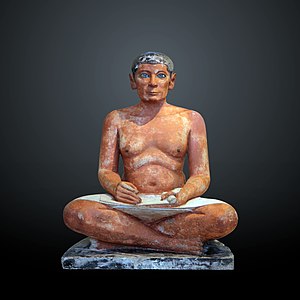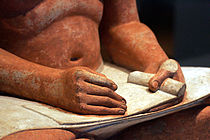- Side view
- From the rear
- Hand
- A 42, another seated 5th Dynasty scribe on display at the Louvre
art.wikisort.org - Sculpture
The sculpture of the Seated Scribe or Squatting Scribe is a famous work of ancient Egyptian art. It represents a figure of a seated scribe at work. The sculpture was discovered at Saqqara, north of the alley of sphinxes leading to the Serapeum of Saqqara, in 1850, and dated to the period of the Old Kingdom, from either the 5th Dynasty, c. 2450–2325 BCE or the 4th Dynasty, 2620–2500 BCE. It is now in the Louvre-Lens.
| The Seated Scribe | |
|---|---|
 | |
| Medium | limestone |
| Dimensions | 53.7 cm (21.1 in) × 44 cm (17 in) × 35 cm (14 in) |
| Location | Room 635, display case 10, Louvre-Lens, , Egypt |
| Owner | French State |
| Collection | Department of Egyptian Antiquities of the Louvre |
| Accession No. | E 3023 |
It is a painted limestone statue, the eyes inlaid with rock crystal, magnesite (magnesium carbonate), copper-arsenic alloy, and nipples made of wood.
Description
This painted limestone sculpture represents a man in a seated position, presumably a scribe. The figure is dressed in a white kilt stretched to its knees. It is holding a half rolled papyrus. Perhaps the most striking part aspect of the figure is its face. Its realistic features stand in contrast to perhaps more rigid and somewhat less detailed body. Hands, fingers, and fingernails of the sculpture are delicately modeled. The hands are in writing position.

Special attention was devoted to the eyes of the sculpture. They are modeled in rich detail out of pieces of red-veined white magnesite which were elaborately inlaid with pieces of polished truncated rock crystal. The back side of the crystal was covered with a layer of organic material which at the same time gives the blue colour to the iris and serves as an adhesive. Two copper clips hold each eye in place. The eyebrows are marked with fine lines of dark organic paint.
The scribe has a soft and slightly overweight body, suggesting he is well off and does not need to do any sort of physical labor. He sits in a cross-legged position that would have been his normal posture at work. His facial expression is alert and attentive, gazing out to the viewer as though he is waiting for them to start speaking. He has a ready-made papyrus scroll laid out on his lap but the reed-brush used to write is missing.[1] Both his hands are positioned on his lap. His right hand is pointing towards the paper as if he has already started to write while watching others speak. He stares calmly at the viewer with his black outlined eyes.
History
The sculpture of the seated scribe was discovered in Saqqara on 19 November 1850, to the north of the Serapeum's line of sphinxes by French archeologist Auguste Mariette. The precise location remains unknown, as the document describing these excavations was published posthumously and the original excavation journal has been lost.

The identity of the person represented remains unknown. The semicircular base of the sculpture suggests that it originally fitted in a larger piece of rock which presumably carried its name and title. This somewhat unusual pose was, it seems, reserved for members of the immediate royal family, although not for the king himself. The statue was dated to the period of the 4th Dynasty, 2620–2500 BC, and is usually associated to the person of Pehernefer. Certain stylistic characteristics, unusual thin lips, broad chest and the posture of the torso might support this theory. The dating itself remains uncertain; the period of the 6th Dynasty has also been suggested. One additional fact in favor of the earlier date is that the statue is represented in "writing" position while it seems that scribes from the period after the 5th Dynasty have been portrayed mainly in "reading" position.
The Seated Scribe was made around 2450–2325 BCE; it was discovered near a tomb made for an official named Kai and is sculpted from limestone.[1] Many pharaohs and high-ranking officials would have their servants depicted in some form of image or sculpture so that when they went to the afterlife they would be able to utilize their skills to help them in their second life. The scribes were some of the very few who knew how to read and write, and were highly regarded and well-paid. Most people were peasant farmers who had no need for literacy, and "although some members of the royal family and high status individuals, as well as officials, priests, and army officers were literate, scribes were needed for operations of the state at all levels."[2] Scribes were used for multitude of things involving everyday Egyptian life, they would be used as tax collectors and were in charge of organizing personnel for activities such as mining, trade and war. Scribes were also used to work on projects like pyramid building and helped communicate between the rulers and the Egyptian people.[2]
| External video | |
|---|---|
 | |
See also
- List of ancient Egyptian scribes
References
- "The Seated Scribe | Louvre Museum | Paris". www.louvre.fr. Retrieved 2015-11-19.
- A. Bard, Kathryn (2007). An Introduction to the Archaeology of Ancient Egypt. Massachusetts, US: Blackwell Publishing. p. 32. ISBN 978-1-4051-1149-2.
- "Au Louvre ! Le scribe accroupi". Louvre. Retrieved 2022-05-04.
- "Seated Scribe". Smarthistory at Khan Academy. Retrieved March 6, 2013.
External links
 Media related to The Seated Scribe at Wikimedia Commons
Media related to The Seated Scribe at Wikimedia Commons- Description of The Seated Scribe on the Louvre Official Site
- 3D preview
На других языках
[de] Sitzender Schreiber
Der sitzende Schreiber ist eine Kalksteinstatue in der ägyptischen Sammlung des Pariser Louvre. Sie wird auf die Zeit des Alten Reichs, 4. oder 5. Dynastie, 2600 bis 2350 v. Chr. datiert. Ein Alternativname ist Hockender Schreiber.[1]- [en] The Seated Scribe
[es] El escriba sentado
El escriba sentado, también conocido como El escriba sentado del Louvre, es una de las estatuas más representativas de la escultura del Imperio Antiguo de Egipto, y una de las más famosas y bien conservadas de toda la Civilización egipcia. Fue esculpida entre los años 2480 y 2350 a. C.[it] Scriba rosso
Lo Scriba rosso o Scriba seduto è uno dei più importanti esempi di arte egizia dell'Antico Regno. Si tratta di una statua in pietra calcarea dipinta raffigurante uno scriba all'opera. La scultura venne scoperta a nord del Corridoio delle Sfingi del Serapeo di Saqqara nel novembre 1850 dall'egittologo francese Auguste Mariette. Attualmente fa parte della collezione di antichità egiziane del Louvre ed è la più celebre di una serie di «scribi» tra cui è anche famoso quello del Museo del Cairo.[ru] Сидящий писец
Сидящий пи́сец (фр. Le Scribe accroupi) — одно из самых известных произведений древнеегипетской скульптуры. Скульптура изображает древнеегипетского писца за работой. Найдена 19 ноября 1850 года в Саккаре археологом Огюстом Мариетом. Датируется IV династией (2620—2500 годы до н. э.). На данный момент находится в Лувре, в Департаменте Древнего Египта (инв. № E 3023).Другой контент может иметь иную лицензию. Перед использованием материалов сайта WikiSort.org внимательно изучите правила лицензирования конкретных элементов наполнения сайта.
WikiSort.org - проект по пересортировке и дополнению контента Википедии




